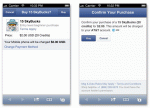
Over the last year, we have seen some notable advances in mobile carrier billing — which lets people pay for services and content on their phones by charging it to their carrier bills: Google expanded its carrier billing services to music and more; Facebook joined the ranks of those offering it, and Amazon has a deal with a company that could help it potentially roll out such services, too. (Noticeably absent is Apple; more on that below.) Now, data shared with TechCrunch by U.S./German carrier billing company mopay provides a look at just how much money these kinds of services are making.
Analysing data from some 4 million transactions across some 300 customers in 80 countries, between 2008 and the end of 2011, mopay says that traffic on mobile billing services has increased four-fold. And along with the traffic increase has been one in value.
Mobile gaming, which has been an early and popular application for carrier billing, is currently the biggest generator of carrier billing revenues, accounting for over half of all transactions and growing at a rate of almost 30% year-to-year. Within that, some areas are doing better than others: traditional mobile games currently bringing in $4.50 per month, and have grown by only 10%; but, perhaps because it is a newer market, social gaming is seeing a much stronger rise: its average revenues per user are up by 40% to over $5 per month.
And on a wider scale, social media applications accounted for 5% of all carrier billing transactions.
Mobile security, mobile ticketing and offers of services specific to your mobile device (eg ringtones) all average at between $2 and $5.
Online Dating has grown by 25% and is currently bringing in $6.50 per month in revenues among individuals using these services.
What’s bringing in premium spending? Premium content — and charity. Mopay says that entertainment offers and “special interest” social networking services are seeing spend of up to $10 per month, an amount only rivaled by charity spend.
Mopay notes that in those situations where carrier billing is enabled, it is leading to more people using it: in over 30 countries where the service is turned on, mopay says that people are on average spending within 80% of their carrier credit lines.
And there seems to be signs that those using carrier billing continue to use it. More than half of users in a period of six months will use carrier billing more than once. Some 55% of users used carrier billing more than five times in that period.
But some countries seem more taken by carrier billing than others: Italy has a lot of single users who return only 25% of the time. Brazil’s carrier billing users, meanwhile, return 70% of the time, with two-thirds of that group making more than five carrier-billing based purchases.
This is partly due, mopay says, to Brazil having a lower penetration of credit cards but a very high mobile penetration; together that drives more interest in using a service like this to make transactions.
Ironically, for all its purported convenience, carrier billing is still a relatively little-used and little-known way for people to pay for content. “As more organizations adopt direct to carrier billing and consumers realize this option exists, we anticipate these numbers will continue to rise in the future,” notes Kolja Reiss, managing director at mopay. Those italics are mine.
Would having a company like Apple get involved in offering carrier billing change the game by raising awareness?
It’s anyone’s guess whether Apple will follow its competitors and offer carrier billing in the App Store — it’s been something rumored here and there, especially around its emerging market strategy. (That would fit nicely with mopay’s own conclusions that these markets are proving much stronger for carrier billing services than some developed markets. It would also run counter to how Apple has developed its content services up to now, with the App Store creating a direct relationship with the device owner and cutting out any operator relationship in the process.)
Apple’s next iPhone event is, if rumors are true, taking place September 12. Since Apple revealed its Passbook service during WWDC in June, most mobile payment attention has been focused on how Apple might leverage Passbook as a step in the direction of an “iWallet” integrating iTunes and using a combination of QR Codes, and possibly more, to trigger an on-phone response to a physical object near it.

